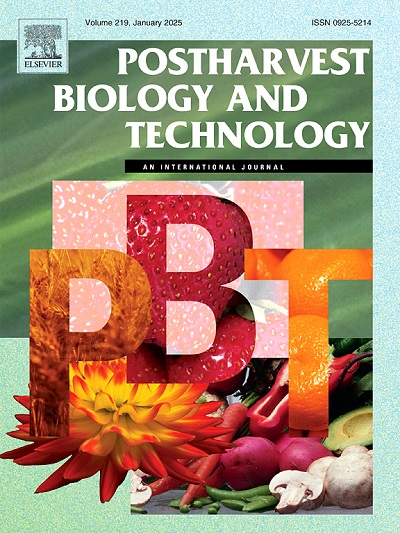利用VIS-NIR高光谱成像技术评价收获后储藏猕猴桃的成熟度
IF 6.8
1区 农林科学
Q1 AGRONOMY
引用次数: 0
摘要
猕猴桃(Actinidia deliciosa)在收获后在低温下长期储存,由于收获条件的影响,在运输过程中会表现出不同的内部质量。果肉硬度(FF)和可溶性固形物含量(SSC)是表征果品品质和成熟度的指标,在贮藏过程中会发生变化。为了保证猕猴桃质量的及时发运,有必要开发猕猴桃果皮质量、果肉质量和成熟度的无损检测技术。在本研究中,利用可见光-近红外(Vis-NIR)高光谱成像技术,建立了猕猴桃FF、SSC和成熟阶段的预测模型。以猕猴桃的贮藏期为研究对象,研究了猕猴桃的FF和SSC,并根据这些特征确定了猕猴桃的5个成熟期。对猕猴桃贮藏0 ~ 120d的可见光-近红外高光谱图像进行测量,提取高光谱光谱。采用偏最小二乘回归和支持向量机回归(SVMR)预测模型预测猕猴桃的果龄和果龄,采用偏最小二乘判别分析(PLS-DA)和支持向量机分类(SVMC)模型对猕猴桃的成熟期进行分类。经过二阶导数预处理的SVMR模型在FF预测中表现最好,R2p、RMSEP和RDP值分别为0.878、3.008 N和2.721。对于SSC预测,采用乘法散射校正(MSC)预处理的SVMR模型表现最好,R2p、RMSEP和RPD值分别为0.940、0.898°Brix和4.055°Brix。采用最大归一化预处理和极差归一化预处理的PLS-DA和SVMC模型成熟度测定准确率最高,分别为91.463 %和91.548 %。本研究结果表明,可见光-近红外高光谱成像技术可用于快速鉴定低温(0℃)猕猴桃的内部品质和贮藏后成熟度。此外,所开发的技术有望有助于确定猕猴桃在储存期间的最佳运输时间。本文章由计算机程序翻译,如有差异,请以英文原文为准。
Evaluating ripeness in post-harvest stored kiwifruit using VIS-NIR hyperspectral imaging
Kiwifruit (Actinidia deliciosa) stored long-term at low temperatures after harvest can exhibit varying internal quality upon shipment due to the influence of harvest conditions. Flesh firmness (FF) and soluble solids content (SSC) are attributes of eating quality and ripeness, which change during storage. To ensure the timely shipment of kiwifruit with uniform quality, the development of non-destructive measurement techniques for FF, SSC, and ripeness is necessary. In this study, models were developed to predict the FF, SSC, and ripeness stages of kiwifruits using visible-near-infrared (Vis-NIR) hyperspectral imaging. The FF and SSC of kiwifruit were investigated according to the storage period, and five ripeness stages were defined based on these characteristics. Vis-NIR hyperspectral images of kiwifruit stored for 0–120 d were measured to extract hyperspectral spectra. Partial least squares regression and support vector machine regression (SVMR) prediction models were developed to predict the FF and SSC of kiwifruit, and partial least square-discriminant analysis (PLS-DA) and support vector machine classification (SVMC) models were developed to classify ripeness stages. The SVMR model with second-order derivative preprocessing exhibited the best performance in FF prediction, with the results of R2p and root mean square of prediction (RMSEP) and RDP values as 0.878, 3.008 N and 2.721, respectively. For SSC prediction, the SVMR model with multiplicative scatter correction (MSC) preprocessing exhibited the best performance, with the results of R2p and RMSEP and RPD values as 0.940, 0.898 °Brix and 4.055, respectively. Ripeness determination achieved the highest accuracy of 91.463 % and 91.548 % for the PLS-DA and SVMC models with maximum normalization preprocessing and range normalization preprocessing, respectively. The results of this study demonstrate that Vis-NIR hyperspectral imaging is useful for rapidly identifying the internal quality and post-storage ripeness stages of kiwifruit stored at low (0℃) temperatures. Furthermore, the developed technology is expected to contribute to determining the optimal shipping time for kiwifruit during storage.
求助全文
通过发布文献求助,成功后即可免费获取论文全文。
去求助
来源期刊

Postharvest Biology and Technology
农林科学-农艺学
CiteScore
12.00
自引率
11.40%
发文量
309
审稿时长
38 days
期刊介绍:
The journal is devoted exclusively to the publication of original papers, review articles and frontiers articles on biological and technological postharvest research. This includes the areas of postharvest storage, treatments and underpinning mechanisms, quality evaluation, packaging, handling and distribution of fresh horticultural crops including fruit, vegetables, flowers and nuts, but excluding grains, seeds and forages.
Papers reporting novel insights from fundamental and interdisciplinary research will be particularly encouraged. These disciplines include systems biology, bioinformatics, entomology, plant physiology, plant pathology, (bio)chemistry, engineering, modelling, and technologies for nondestructive testing.
Manuscripts on fresh food crops that will be further processed after postharvest storage, or on food processes beyond refrigeration, packaging and minimal processing will not be considered.
 求助内容:
求助内容: 应助结果提醒方式:
应助结果提醒方式:


